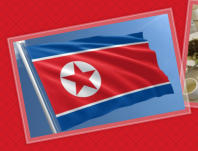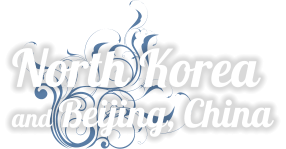



© Nova Fisher novatravels.net

Early wars
My guide told me – • In 612 the Chinese invaded North Korea with 3 million army which stretched to 400 km as they marched. The Koreans fought and killed half of them and the rest retreated. (The Goguryeo – Sui war was a series of invasions into Goguryeo, of the three kingdoms of Korea between 598 and 614 AD. I can find no mention anywhere of 3 million troops) • In 645 another invasion by 1 million Chinese but the Koreans killed all but 217 of them. (The Goguryeo–Tang War occurred from 645 to 668 and was fought between the Goguryeo Kingdom and the Tang Empire. I can’t find any mention of the 1 million Chinese.) • In 668, the Koreans won. (My research says that in 668, exhausted from numerous military attacks and suffering from internal political chaos, the kingdom of Goguryeo and the remnants of Baekje army succumbed to the numerically superior armies of the Tang Dynasty and Silla, one of the three kingdoms of Korea.) • The Great Wall of China was built to keep out the Koreans. • In 1388 Korea attempted to invade China to retake what the Chinese had taken from them. 53,000 troops were led by Yi Seong-Gye. However, he returned to take power from the King and he overthrew the Goryeo Dynasty. He told the king he was returning because: - Korea was a small country invading a much larger country. - with no troops in the country, Japan could attack from the south. - It was the rainy season and the weapons were not effective with the arrows going rusty. - the soldiers were suffering with sickness.Korean War
My guides told me that the Americans had invaded North Korea with considerable force in 1950 and that’s what started the Korean war. There are many well documented accounts of the Korean war that dispute North Korea’s view: On June 25, 1950, the Korean War began when some 75,000 soldiers from the North Korean People’s Army poured across the 38th parallel, the boundary between the Soviet-backed Democratic People’s Republic of Korea to the north and the pro-Western Republic of Korea to the south. This invasion was the first military action of the Cold War. By July, the United Nations with the United States as the principle participant, entered the war to support South Korea. After some early back-and-forth across the 38th parallel, the fighting stalled and casualties mounted with nothing to show for them. Meanwhile, American officials tried hard to create some sort of armistice with the North Koreans as, the alternative, they feared, would be a wider war with Russia and China, or even, as some warned, World War III. Finally, in July 1953, the Korean War came to an end. In all, about 5 million soldiers and civilians lost their lives during the war. The Korean peninsula is still divided today. Negotiations in 1954 produced no further agreement, and the front line has been accepted ever since as the de facto boundary between North and South Korea.Great Wall of China
I was told that the Great Wall of China was built to keep out the Koreans following the early wars. According to other sources: The history of the Great Wall of China began when fortifications built by various states during the Spring and Autumn (771–476 BC) and Warring States periods (475–221 BC) were connected by the first emperor of China, Qin Shi Huang, to protect his newly founded Qin dynasty (221–206 BC) against incursions by nomads from Inner Asia. The Eurasian nomads were a large group of nomadic peoples from the Eurasian Steppe, who often appear in history as invaders of Europe, the Middle East and China. The generic title encompasses the varied ethnic groups who have at times inhabited the steppes of Central Asia, Mongolia, and what is now Russia. The Great Wall of China visible today largely dates from the Ming dynasty, as they rebuilt much of the wall in stone and brick, often extending its line through challenging terrain.


History
This is the history of Korea as far as I
can establish
First Kingdom c. 7thC BC Three Kingdoms: Gorguyeo, Baekie, Silla 18 BC North-South Kingdoms: Later Silla, Balhae 698 Goryeo dynasty 918 Joseon dynasty 1392 Korean empire 1897 Japanese Occupation 29/08/1910 Declaration of Independence 01/03/1919 Provisional Government 11/04/1919 Liberation from Japan 15/08/1945 Foundation of DPRK 09/09/1948 Kim Il-Sung 1948-1994 Korean War 1950-1953 Chinese withdrawal 01/10/1958 Current constitution 27/12/1972 Admitted to the United Nations 17/09/1991 The Famine 1994-1998 Kim Jong-Il 1994-2011 Kim Jong Un 2011 -


The Famine
(known as the Arduous March)
In the 1990s, a devastating famine struck North Korea. According to the government it was a result of a series of droughts and floods and the collapse of the Soviet Union which reduced the supply of food. However, International sources quote economic mismanagement and the loss of Soviet support as the cause of the food decline. Estimates of the death toll vary widely. Out of a population of approx. 22 million, between 240,000 and 3.5 million died from starvation or hunger-related illnesses. Domestic agriculture has improved significantly but agricultural scientists believe that the country is still unable to feed all of its population. According to a 2017 report by the Food and Agricultural Organization of the United Nations (FAO), two out of every five North Koreans are undernourished. (I can’t say that I saw any sign of this.) Around 30 percent of the country's food comes from external sources. Foreign aid provides a good portion of that but funding for aid programs has been getting scarce. I have read in some articles that North Koreans go hungry because their government wants them to as a method of control over the people. I have read that he term "Arduous March", or "The March of Suffering" became a metaphor for the famine following a state propaganda campaign in 1993. The official ‘government’ newspaper, Rodong Sinmun urged the North Korean citizens to remember the (doublful) fable from Kim Il Sung’s time as a commander of a small group of anti- Japanese guerrilla fighters. As part of this state campaign, uses of words such as 'famine' and 'hunger' were banned because they implied government failure. Citizens who said deaths were due to the famine could be in serious trouble with the authorities.
Click on any photo to see a slideshow of larger versions




© Nova Fisher novatravels.net
Early wars
My guide told me – • In 612 the Chinese invaded North Korea with 3 million army which stretched to 400 km as they marched. The Koreans fought and killed half of them and the rest retreated. (The Goguryeo – Sui war was a series of invasions into Goguryeo, of the three kingdoms of Korea between 598 and 614 AD. I can find no mention anywhere of 3 million troops) • In 645 another invasion by 1 million Chinese but the Koreans killed all but 217 of them. (The Goguryeo–Tang War occurred from 645 to 668 and was fought between the Goguryeo Kingdom and the Tang Empire. I can’t find any mention of the 1 million Chinese.) • In 668, the Koreans won. (My research says that in 668, exhausted from numerous military attacks and suffering from internal political chaos, the kingdom of Goguryeo and the remnants of Baekje army succumbed to the numerically superior armies of the Tang Dynasty and Silla, one of the three kingdoms of Korea.) • The Great Wall of China was built to keep out the Koreans. • In 1388 Korea attempted to invade China to retake what the Chinese had taken from them. 53,000 troops were led by Yi Seong-Gye. However, he returned to take power from the King and he overthrew the Goryeo Dynasty. He told the king he was returning because: - Korea was a small country invading a much larger country. - with no troops in the country, Japan could attack from the south. - It was the rainy season and the weapons were not effective with the arrows going rusty. - the soldiers were suffering with sickness.Korean War
My guides told me that the Americans had invaded North Korea with considerable force in 1950 and that’s what started the Korean war. There are many well documented accounts of the Korean war that dispute North Korea’s view: On June 25, 1950, the Korean War began when some 75,000 soldiers from the North Korean People’s Army poured across the 38th parallel, the boundary between the Soviet-backed Democratic People’s Republic of Korea to the north and the pro- Western Republic of Korea to the south. This invasion was the first military action of the Cold War. By July, the United Nations with the United States as the principle participant, entered the war to support South Korea. After some early back-and-forth across the 38th parallel, the fighting stalled and casualties mounted with nothing to show for them. Meanwhile, American officials tried hard to create some sort of armistice with the North Koreans as, the alternative, they feared, would be a wider war with Russia and China, or even, as some warned, World War III. Finally, in July 1953, the Korean War came to an end. In all, about 5 million soldiers and civilians lost their lives during the war. The Korean peninsula is still divided today. Negotiations in 1954 produced no further agreement, and the front line has been accepted ever since as the de facto boundary between North and South Korea.Great Wall of China
I was told that the Great Wall of China was built to keep out the Koreans following the early wars. According to other sources: The history of the Great Wall of China began when fortifications built by various states during the Spring and Autumn (771–476 BC) and Warring States periods (475–221 BC) were connected by the first emperor of China, Qin Shi Huang, to protect his newly founded Qin dynasty (221–206 BC) against incursions by nomads from Inner Asia. The Eurasian nomads were a large group of nomadic peoples from the Eurasian Steppe, who often appear in history as invaders of Europe, the Middle East and China. The generic title encompasses the varied ethnic groups who have at times inhabited the steppes of Central Asia, Mongolia, and what is now Russia. The Great Wall of China visible today largely dates from the Ming dynasty, as they rebuilt much of the wall in stone and brick, often extending its line through challenging terrain.

History
This is the history of Korea as far as I can
establish
First Kingdom c. 7thC BC Three Kingdoms: Gorguyeo, Baekie, Silla 18 BC North-South Kingdoms: Later Silla, Balhae 698 Goryeo dynasty 918 Joseon dynasty 1392 Korean empire 1897 Japanese Occupation 29/08/1910 Declaration of Independence 01/03/1919 Provisional Government 11/04/1919 Liberation from Japan 15/08/1945 Foundation of DPRK 09/09/1948 Kim Il-Sung 1948-1994 Korean War 1950-1953 Chinese withdrawal 01/10/1958 Current constitution 27/12/1972 Admitted to the United Nations 17/09/1991 The Famine 1994-1998 Kim Jong-Il 1994-2011 Kim Jong Un 2011 -





























